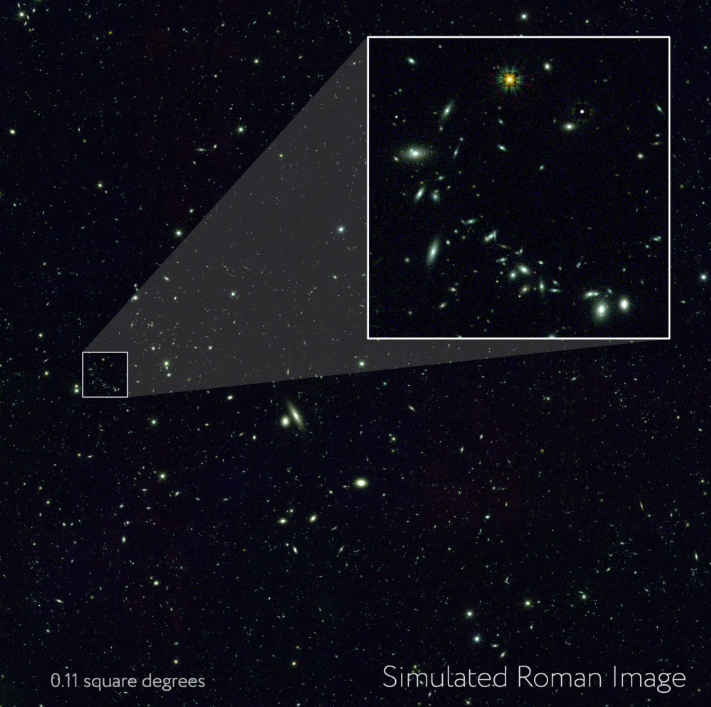Scientists have used supercomputers to create a “synthetic universe” that will help predict what the next generation of super-telescopes will see upon opening their eyes to the cosmos.
These telescopes will both be “dark universe” detectives in that they will investigate the two most pressing mysteries in cosmology: dark energy and dark matter, sometimes referred to collectively as the “dark universe.” Notably, the news comes as the $10 billion James Webb Space Telescope (JWST) celebrates two years of delivering scientific results today, July 12. The JWST has had an immense impact on astronomy, with researchers still working to understand some of the surprising things it has seen.
The newly generated synthetic cosmos should help scientists avoid at least some of the same elements of surprise when both NASA’s Nancy Grace Roman Space Telescope and the Vera C. Rubin Observatory start exploring the universe, though these telescopes will undoubtedly still reveal some unexpected delights of their own.
This simulated universe was created with the Theta supercomputer at the Argonne National Laboratory in Illinois as part of a wider project called OpenUniverse.
Related: Weird physics at the edges of black holes may help resolve lingering ‘Hubble trouble’
The copycat cosmos consists of nearly 4 million simulated images depicting the universe as it should appear to Roman, set to launch in 2027, and the Earth-based Rubin, currently under construction at the peak of Cerro Pachón, a mountain in northern Chile.
“Using Argonne’s now-retired Theta machine, we accomplished in about nine days what would have taken around 300 years on your laptop,” Katrin Heitmann, deputy director of Argonne’s High Energy Physics division, who managed the project’s supercomputer time, said in a statement. “The results will shape Roman and Rubin’s future attempts to illuminate dark matter and dark energy while offering other scientists a preview of the types of things they’ll be able to explore using data from the telescopes.”
Illuminating the dark universe
Despite being very different observatories, Roman, located around a million miles from Earth, and Rubin, located at high altitudes in the dry and clear atmosphere of northern Chile, will both investigate the mystery of dark energy.
“Dark energy” is a placeholder name for the mysterious force driving the ever-accelerating expansion of the cosmos; the nature of such expansion remains a mystery itself. This substance has proven troubling for scientists because dark energy dominates the universe, accounting for around 68% to 70% of the total matter-energy budget of the cosmos.
The OpenUniverse simulation could help scientists better understand the signatures of dark energy they will see when Roman and Rubin start delivering images. This could mean that even faint fingerprints of dark energy could yield important scientific results right out of the gate.
“OpenUniverse lets us calibrate our expectations of what we can discover with these telescopes,” Jim Chiang, a scientist at the National Accelerator Laboratory who helped create the simulations, said in the statement.”It gives us a chance to exercise our processing pipelines, better understand our analysis codes, and accurately interpret the results so we can prepare to use the real data right away once it starts coming in.”

Roman and Rubin will also be influential in understanding dark matter, which accounts for around 26% of the remaining matter and energy in the cosmos. This mission will be particularly poetic for Rubin because it is named for Vera Rubin, the American astronomer who established the presence of dark matter in galaxies.
Dark matter is problematic because it does not interact with light nor ordinary matter — or, if it does, these interactions are so weak and rare we can’t detect them. This means dark matter can’t be composed of electrons, protons and neutrons like everyday matter is. That’s because everyday matter certainly interacts with light, and with itself.
Astronomers can only infer the presence of dark matter from its interaction with gravity, which, in turn, influences everyday matter and the passage of light.
Rubin and Roman — named after Nancy Grace Roman, NASA’s first head of science, affectionately known as the “mother of Hubble” and who pushed for powerful space telescopes to be built in the first place — will hunt for these effects.
This dark universe investigation set to be undertaken by Rubin and Roman will be no mean feat. Rubin, set to begin operating in 2025, will rely on the largest digital camera ever built to investigate the dark universe, while Roman will offer a much wider view of the cosmos than the Hubble Space Telescope or the JWST can.
In fact, even simulating what these telescopes would see was a complicated task requiring a huge amount of computing power. Now that its is done, however, the OpenUniverse team is confident the benefits will soon be self-evident.
“We made phenomenal strides in simplifying these pipelines and making them usable,” Kiessling concluded. “Now we want people to start working with the simulations to see what improvements we can make and prepare to use the future data as effectively as possible.”